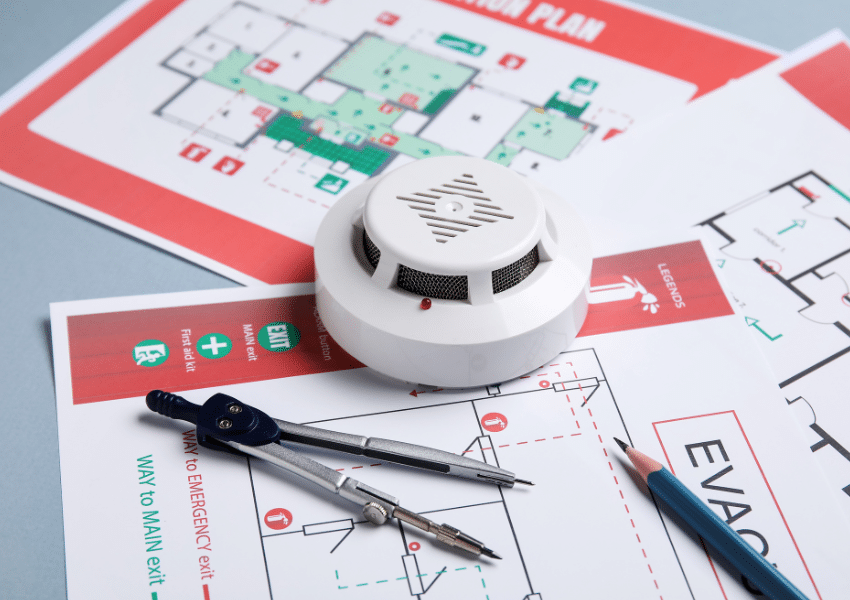When fire breaks out, every second counts. Knowing exactly what to do—and what to avoid—can mean the difference between safety and tragedy. Whether you’re at home, at work, or out in public, understanding how to respond in a fire emergency gives you the power to act quickly, protect loved ones, and make it out safely.
Understanding the Phases of a Fire
Before you can respond effectively, it helps to understand how a fire behaves. Fires move through distinct phases, though the timing can vary depending on what is burning and where the fire occurs:
- Incipient Phase – This is the very beginning, when the fire first ignites. If detected quickly, it may still be possible to put it out safely with the right tools.
- Growth Phase – Flames spread, heat builds rapidly, and conditions begin to change. This is when a small fire can suddenly get out of control.
- Fully Developed Phase – At its peak intensity, a fire consumes all available fuel, producing thick smoke and toxic gases. Escape is the only safe option.
- Decay Phase – As the fire runs out of fuel, flames and heat decrease, but smoke and gases can still be dangerous.
What to Do in a Fire Emergency
When you encounter fire, your actions need to be quick, calm, and deliberate. Here are the key “Do’s” to remember:
1. Act Early if It’s Safe
If you catch the fire in its earliest stage (the incipient phase), and you have the right type of extinguisher, you may be able to stop it from spreading. Always aim the extinguisher at the base of the flames, not the middle or top.
In the kitchen:
- Turn off the heat source.
- Smother small stovetop flames with a metal lid, baking sheet, or fire blanket.
- Use baking soda or salt on grease fires—but never water or flour.
- Follow these tips for other ways to put out a fire.
- If a fire starts inside your oven or microwave, keep the door closed. The lack of oxygen will usually cause the fire to die down.
If the fire is spreading quickly, do not try to fight it. Get out immediately and call 911.
2. Get to Safety
Plan for at least two exits from every room in your home. Fires often make the most obvious path unusable. Heavy smoke can quickly disorient you, so it helps to know the layout of your home by memory. Practice fire drills with your family so that everyone knows how to react without hesitation.
3. Stay Low
Smoke rises and carries carbon monoxide, which can make you dizzy or even cause unconsciousness. Crawling low to the ground gives you cleaner air to breathe and increases your chance of escape.
4. Stop, Drop, and Roll
If your clothing catches fire, don’t run. Running only fuels the flames. Instead, stop, drop to the ground, and roll back and forth while covering your face. This smothers the flames and helps prevent serious injury.
5. If You’re Trapped
Sometimes escape isn’t possible. If you can’t get out:
- Stay away from doors that are hot to the touch.
- Block smoke by placing wet towels or blankets along the bottom of doors.
- Open windows cautiously, crouching down to avoid rising smoke and heat.
- Signal for help by waving a flashlight or cloth out the window.
What NOT to Do in a Fire Emergency
Just as important as knowing what to do is knowing what not to do. Certain instinctive reactions can actually make things worse:
- Don’t use elevators. Fires can cause electrical failures or trap you inside. Always use the stairs.
- Don’t pour water on grease fires. Water splashes burning oil and creates explosive steam.
- Don’t pour flour on a fire. Flour is combustible. Stick with baking soda, salt, or a fire extinguisher.
- Don’t use water on electrical fires. Water conducts electricity and can cause electrocution.
- Don’t fan flames. Adding oxygen only makes a fire grow.
- Don’t stand too close or reach over flames. Loose clothing can ignite quickly.
- Don’t move burning objects. This can spread flames to new areas.
- Don’t aim a fire extinguisher at the flames themselves. Remember: always target the base of the fire.
Preparing Before a Fire Happens
While these tips can help in the moment, preparation is your best defense. Here’s how to protect yourself and your loved ones:
- Install smoke alarms on every level of your home, especially near bedrooms. Test smoke detectors monthly and replace batteries at least once a year.
- Create and practice a fire escape plan with your household. Make sure every member—children included—knows how to get out and where to meet once outside.
- Keep fire extinguishers accessible. Place them in the kitchen, garage, and near exits. Learn how to use them before an emergency arises.
- Understand the common causes of fires so you can take steps to fireproof your home and minimize these risks.
- Know your insurance coverage. Even when you do everything right, fires happen. Having the right coverage can make the recovery process easier and less stressful.
This article is furnished by California Casualty, providing auto and home insurance to educators, law enforcement officers, firefighters, and nurses. Get a quote at 1.866.704.8614 or www.calcas.com.
- Hazards in Older Homes - December 30, 2025
- Creative Storage Hacks for Small Apartments - December 26, 2025
- Tires 101: Rotation, Alignment and Balancing Explained - December 22, 2025

